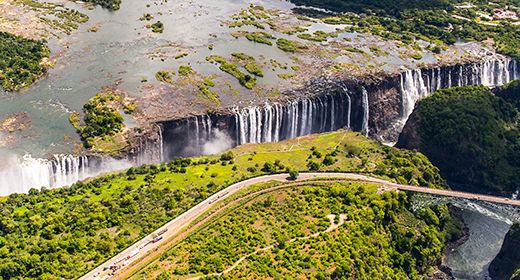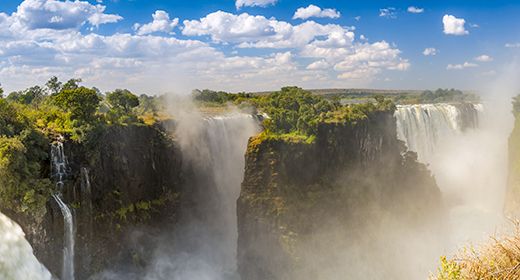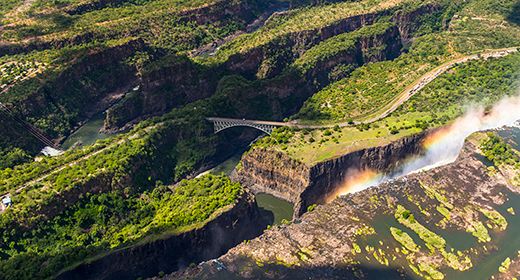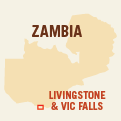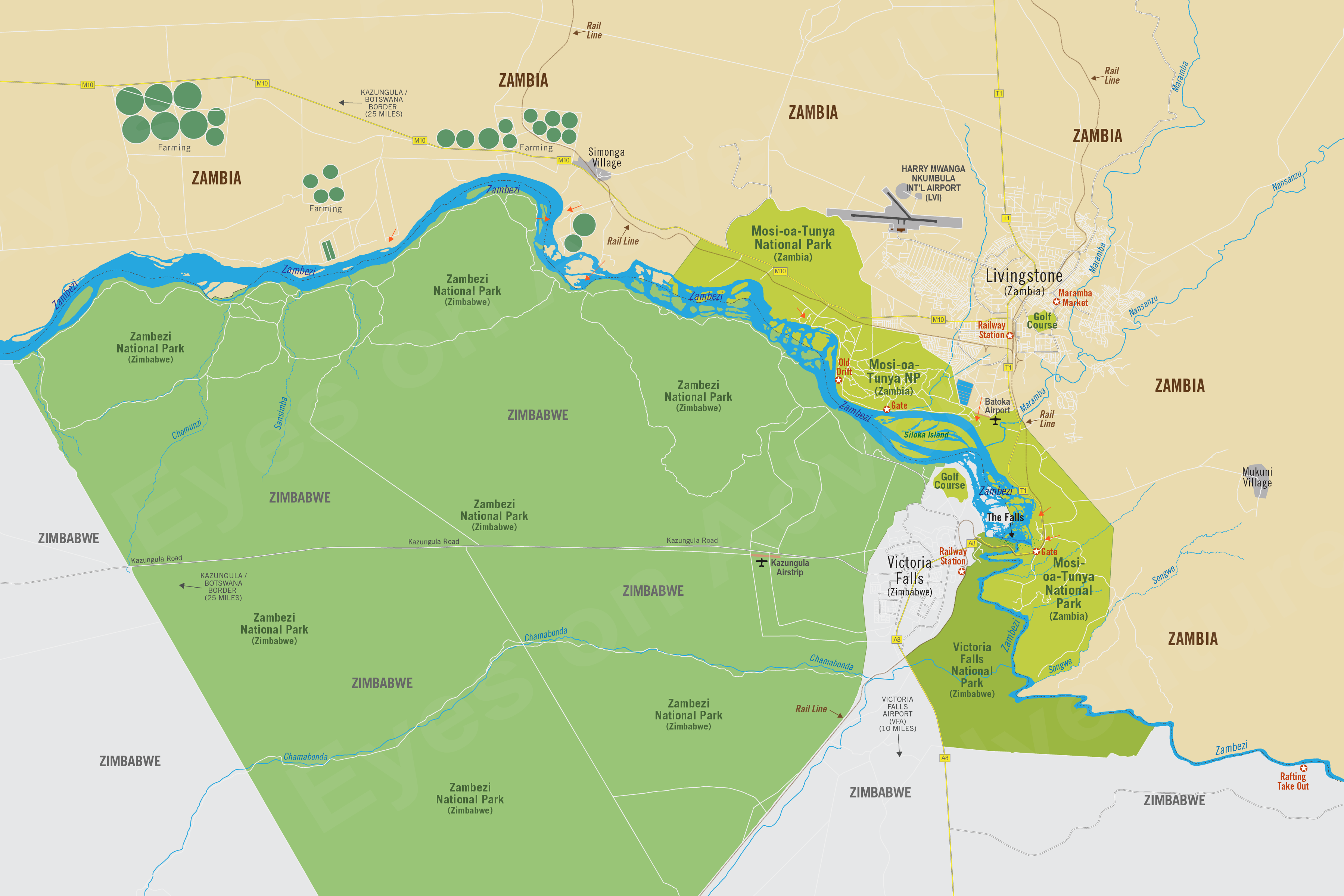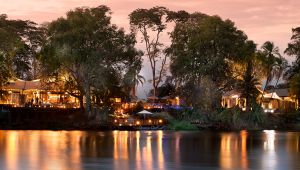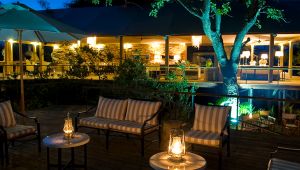Livingstone
(incl. The Victoria Falls, Mosi-oa-Tunya NP)
Region Links: Kafue, Livingstone, Lower Zambezi (Zambia), North Luangwa, South Luangwa
Highlights
- Tour The Victoria Falls, one of the world's greatest waterfalls.
- Go white-water rafting in the spectacular gorges below The Falls.
- Canoe, cruise or fish on the beautiful Zambezi River above The Falls.
- Bungee jump off the Falls Bridge or take the Flight of the Angels overhead.
- Visit the quaint Mosi-Oa-Tunya National Park along the river.
EOA Recommends: Stanley Safari Lodge, The Zambezi Sun Hotel, Thorntree River Lodge, Toka Leya Camp, Tongabezi Lodge
The Victoria Falls, known locally as 'Mosi-oa-Tunya' (the Smoke that Thunders), are one of the great wonders of the natural world. Livingstone town and the Zambian riverfront offer plenty of accommodation and a huge array of adventure activities.
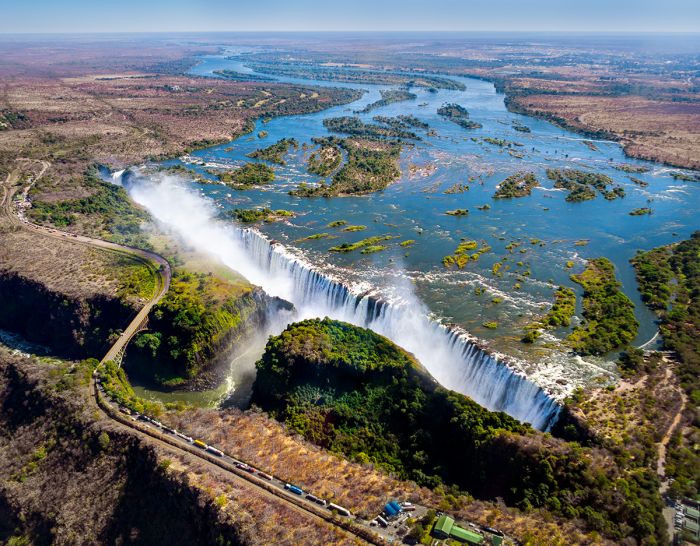
The Zambezi River as it pours over the Victoria Falls.
The Zambezi River, which flows over The Victoria Falls, forms the border between Zambia and Zimbabwe, with an impressive bridge spanning the deep gorge below The Falls and connecting the two countries. The Falls can be viewed from either country and many visitors obtain visas to allow viewing from both sides.
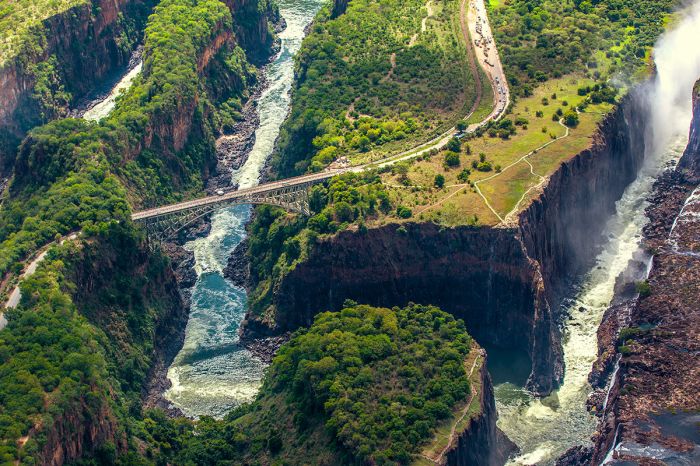
The Falls Bridge and walking trails (Zimbabwe and Zambia).
The small town of Victoria Falls (on the Zimbabwe side) was long the preferred base for visitors coming to The Falls, while Livingstone town in Zambia was largely overlooked. However, with Zimbabwe's political tension and instability over the past two decades, a good portion of the tourism has shifted to the Zambian side.
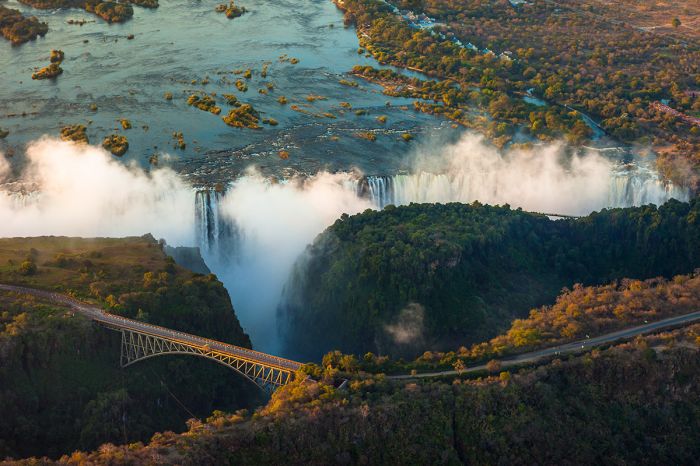
Mosi-oa-Tunya, meaning "The Smoke That Thunders".
Besides seeing The Falls, the big draw for tourists are the myriad adventure activities offered here. Popular options that will get your blood flowing include flights above The Falls (helicopter or microlight), bungee jumps off The Falls Bridge, white-water rafting, canoeing, kayaking, the gorge swing, canopy tours, zip lining, safaris in the Mosi-Oa-Tunya National Park, and more.
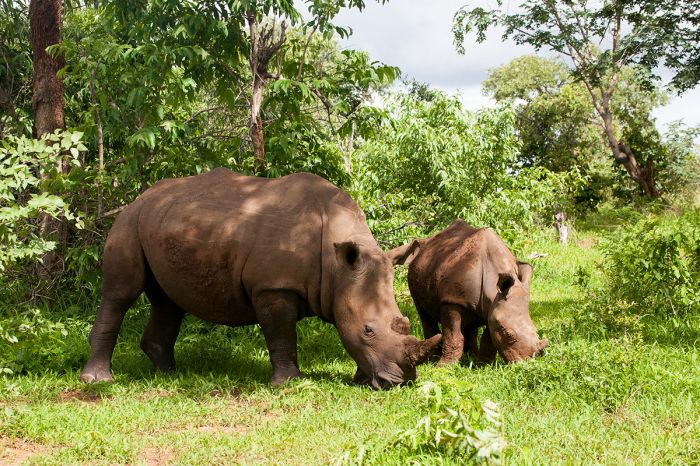
A white rhino with her calf in Mosi-oa-Tunya National Park.
If you are planning a safari anywhere in Southern Africa (South Africa, Botswana, Zimbabwe, or Zambia), then adding a visit to see The Victoria Falls is logistically quite easy and a great way to add diversity to your adventure!
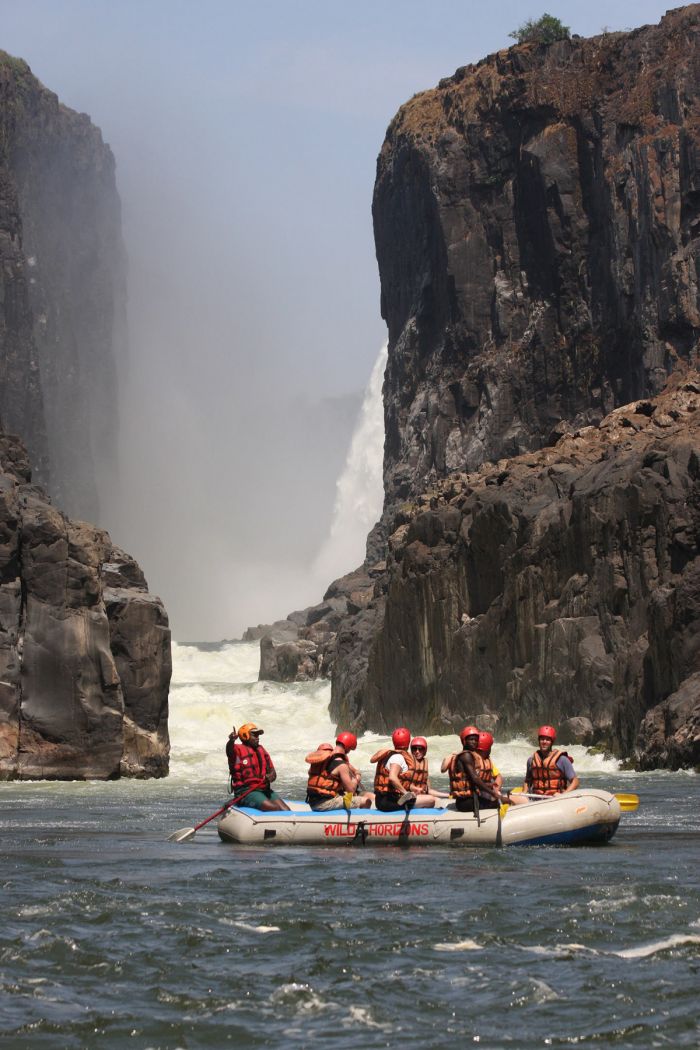
White-water rafting below The Falls (Copyright © Wild Horizons).
Read More...
Adrenaline Activities, Adventure Sports, Batoka Gorge, Boiling Pot, Bungee Jumping, Devil's Pool, Falls Tour, Fishing, Flight of the Angels, Geological History, High Water, Human History, Livingstone Island, Livingstone Town, Low Water, Markets, Mosi-oa-Tunya, Post-Independence History, River Cruises, Sights & Day Tours, The Victoria Falls, Village Visits, Water Flow Levels, White-Water Rafting
Geological History
The upper Zambezi River, which flows south from northern Zambia and over the Victoria Falls before turning east to the Indian Ocean, originally flowed south through Zambia and Botswana and into the Limpopo River on the northern border of South Africa. The Limpopo, as it does today, also emptied into the Indian Ocean.
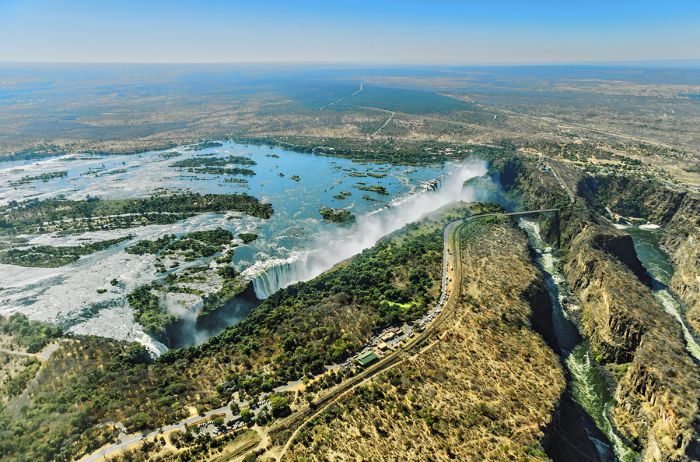
The Zambezi River and Victoria Falls.
Around 5 million years ago, an uplifting of the land in the Kalahari Desert (in Botswana) blocked the Zambezi's south drainage route and shifted the river's course. The result created a huge inland paleo-lake known as Lake Makgadikgadi in Botswana. Today, the remains of this lake are the Makgadikgadi Salt Pans.
Over many thousands of years, Lake Makgadikgadi continued to grow in size until around 20 000 years ago, when it reached its holding capacity and began to overflow to the northeast via the Matetsi River. This outflow caused the Zambezi River's middle section to form, directing it eastward instead of south into Botswana.
The water of this newly formed section of the Zambezi River flowed east and over time, slowly cut into a layer of basalt rock (700-1000 feet/200-300 m deep) that was laid down by volcanic activity around 150 million years ago. Basalt is made from volcanic magma and is very hard, but fissures in the rock, created when the magma cooled, created faults in the rock that were eroded by the river over time, causing huge blocks to crack off, creating the Batoka Gorge.
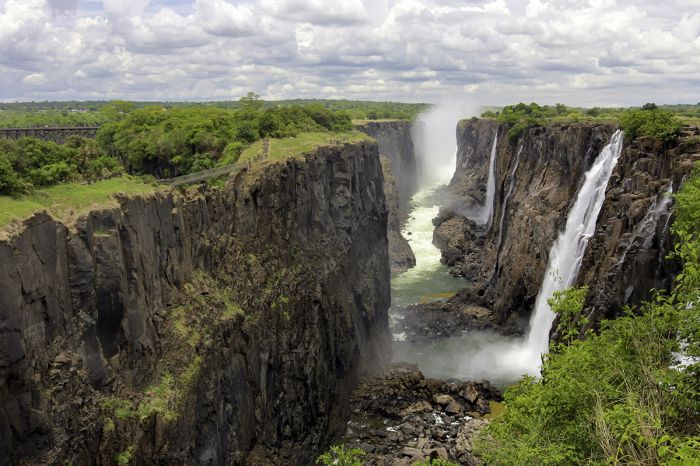
Looking into First Gorge from the Zambian bank.
Over thousands of years, the water flowing over the basalt and into the growing gorge has continued to eat away the surrounding rock wherever the flow was heaviest, creating six individual gorges.
As the erosion of the basalt has worked its way back upstream, there have been eight prior positions of the waterfalls into the expanding gorge (see image). Excavations around the current Falls indicate that they have only existed in this location for around 75 000 years. Downstream from the falls is known as the Lower Zambezi, which flows northeast into what is today Mozambique, before shifting course southeast and out to the Indian Ocean.
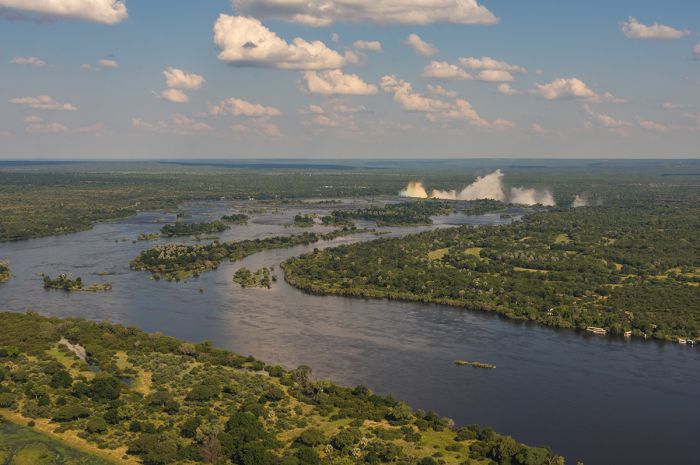
The Zambezi River above The Falls with the rising spray.
Human History
The spectacular physical spectacle of the Victoria Falls has made this region a place of great interest to our ancestors for many thousands of years. We know from fossil evidence that early hominids have inhabited this place for around 2 to 3 million years. Stone tools dating back 50 000 years have been discovered, indicating that humans lived here throughout the Stone Age.
The Khoisan, a hunter gatherer people, displaced the Stone Age clans around 2 000 years ago. Later, around 400 AD, the Bantu-speaking BaTonga (or Tonga) people migrated south into the region and assimilated with the early humans. Today these people are called the Batoka or Tokaleya and they still live here. Various dialects of the Tonga language are widely spoken throughout the area. In the 19th century, the Matabele (Ndebele) and Makalolo tribes also arrived in the region from Zimbabwe.
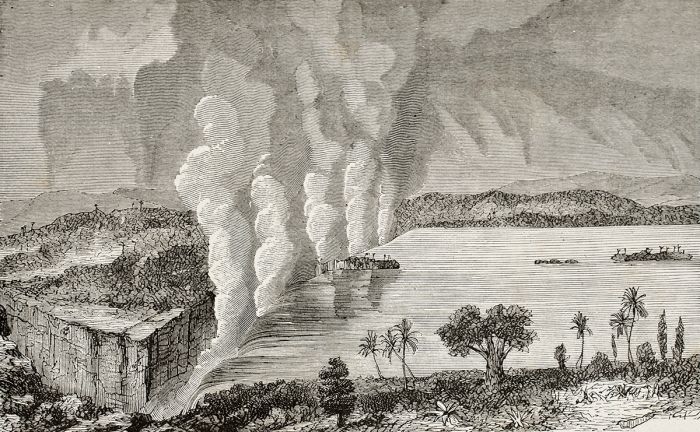
Old illustration of Victoria Falls, circa 1873 (artist unknown).
In November 1855, David Livingstone, the acclaimed British explorer, became the first European to see the Falls. Livingstone traveled east along the upper Zambezi River system between 1852 and 1856. Traveling by canoes and guided by knowledgeable local tribesmen, his expedition had been told about the mighty falls, but nothing could prepare him for what he saw.
Livingstone's famous quote describes his feelings upon the the falls: "No one can imagine the beauty of the view from anything witnessed in England. It had never been seen before by European eyes; but scenes so lovely must have been gazed upon by angels in their flight." It was Livingstone that gave the falls their English name in honor of the then queen of Britain, Victoria.
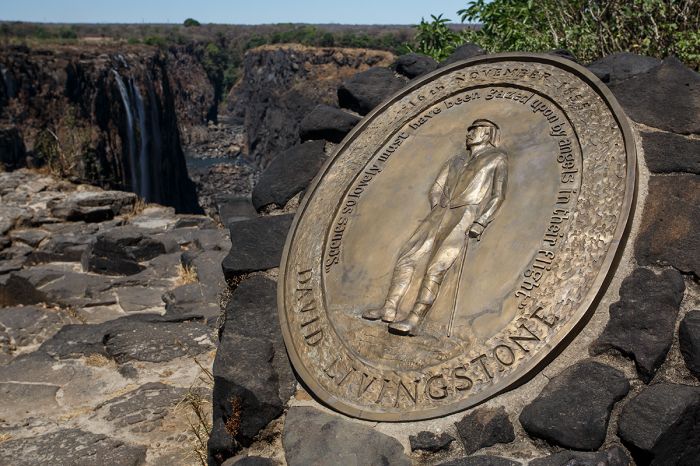
Memorial to David Livingstone at The Falls.
European settlement around the Falls began around 1900 with the arrival of workers for Cecil Rhodes' British South Africa Company (BSAC). The BSAC obtained mineral rights on both sides of the Zambezi River, seeking to exploit the region for minerals, timber, and elephant ivory.
Rhodes also sought to build a railway connecting the Cape of Africa to Cairo, Egypt. Heretofore, river crossings were conducted by a tow-barge at Old Drift, just upstream from The Falls. Construction of the new railway required a bridge across the Zambezi, and Rhodes, who never visited the falls in person, wanted it to pass over The Falls. The steel bridge was prefabricated in England, took 14 months to build, and was completed in 1905 and dubbed the Zambezi Bridge (later known as the Victoria Falls Bridge).
During the British colonization of Northern and Southern Rhodesia (Zambia and Zimbabwe), The Falls became a popular tourist attraction, and the small town of Livingstone (renamed from Old Drift) became the original visitor here. Tourism shifted in the late 1940s to the town of Victoria Falls on the southern banks.
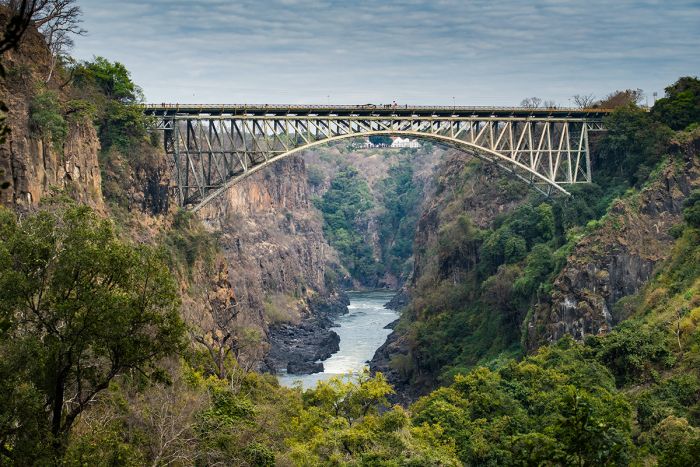
The Victoria Falls Bridge, completed in 1905.
Post-Independence History
In 1964, Northern Rhodesia gained independence from the British, becoming the Independent State of Zambia. The new government was a black majority, which complied with the recently adopted British policy of "no independence before majority rule".
The rapid decolonization of Africa in the early 1960s alarmed the white minority government in Southern Rhodesia (later to become Zimbabwe) and in a move to delay the transition to black majority rule, it declared a Unilateral Declaration of Independence (UDI), which was not recognized by the global community.
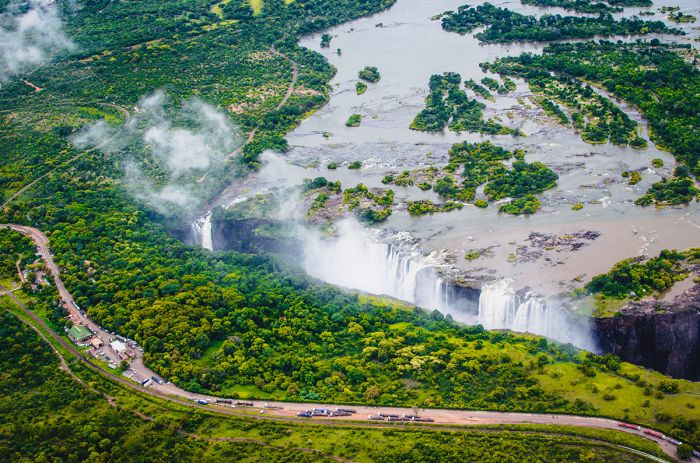
Aerial view over The Victoria Falls.
Political violence ensued in Southern Rhodesia and the Victoria Falls Bridge was closed for travel throughout most of the UDI crisis, which lasted until 1980, when Zimbabwe gained its independence with black majority rule.
The 1980s were a period of renewed tourism for The Falls and it became one of the most visited destinations in Southern Africa. Adventure sports along the Zambezi River around The Falls gained popularity, including white-water rafting, bungee jumping from the bridge, flights above the falls on microlight and helicopter, canoeing, fishing, and more.
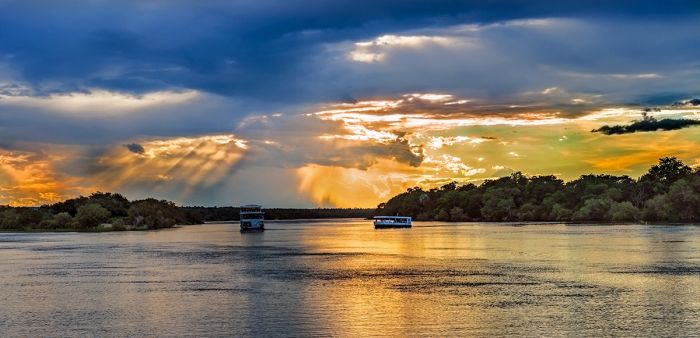
Sunset cruises on the river are amazing.
From 1980 until the the early 2000s, most visitors based themselves on the Zimbabwe side of The Falls in the town of Victory Falls. This was mostly due to the far better tourism infrastructure, hotels, and other visitor facilities in Vic Falls.
When Zimbabwe's land reform policies were enacted in 2000 and white landowners were violently forced off their farms, tourism to Zimbabwe collapsed, and visitors to The Falls began staying in Livingstone, Zambia instead of Victoria Falls. Zimbabwe has since recovered from its tourism slump and today visitors are staying on both sides of The Falls.
In 1989, The Victoria Falls were declared a UNESCO World Heritage Site.
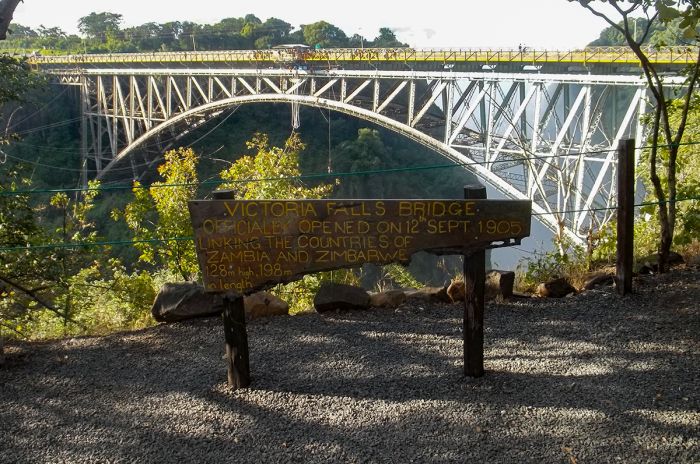
The Victoria Falls Bridge, opened in 1905.
The Victoria Falls
The Victoria Falls is often described as the Earth's largest waterfall and, while it is one of the biggest, it is neither the highest (Angel Falls in Venezuela on the Kerepacupai Meru River), nor the widest (Khone Phapheng Falls in Laos on the Mekong River).
The Falls are called 'Mosi-oa-Tunya' in the local Lozi language, meaning "The Smoke That Thunders", referring to the thunderous sound of the water crashing into the gorge and the "smoky" spray that rises above it.
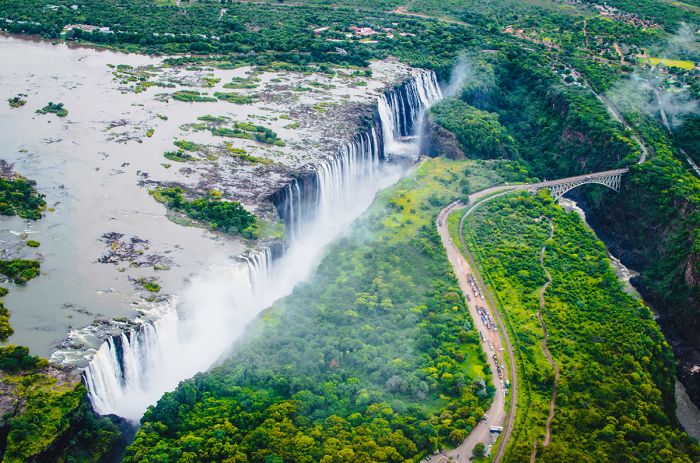
Overhead of The Falls with Livingstone Island at the lip.
At 5 604 feet (1 708 meters) wide and 354 feet (108 meters) high, the Victoria Falls forms the largest single curtain of falling water in the world, measuring 1.5 times the width of Niagara Falls and twice as high. In terms of combined height and width, only Brazil's Iguazu Falls is comparable.
The border between Zimbabwe and Zambia runs through the middle of the Zambezi River, both upstream and downstream of The Falls, so the river and waterfall are shared by both countries. In order to view both sides of The Falls, visitors must have a visa for both countries.
For hundreds of miles upstream of The Falls, the Zambezi River flows over a flat sheet of basalt rock, which is made from molten magma and is very hard. This long stretch of the Zambezi has no bounding mountains nor deep valleys, just a level plateau over which it flows. The river is dotted with many vegetation-covered islands, increasing in number as the river approaches The Falls.
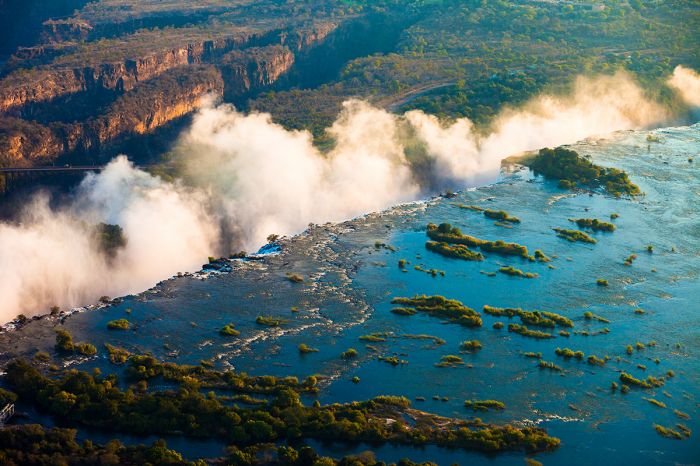
Looking down over the lip of The Falls.
Two significant islands along the crest of The Falls are big enough that they separate the curtain of water even at its highest flood level: Cataract Island (or Boaruka Island) near the Zimbabwe bank and Livingstone Island near the middle, which is named for the spot where David Livingstone first viewed the falls. At lower flood levels, there are numerous smaller islands that divide The Falls into smaller streams.
At high water, there are five major falls comprising the entire Victoria Falls; beginning from the western bank (Zimbabwe side), they are: Devil's Cataract (west of Cataract Island), Main Falls (between Cataract and Livingstone Islands), Horseshoe Falls (directly east of Livingstone Island), Rainbow Falls (the highest), and Eastern Cataract (along the eastern/Zambia bank).
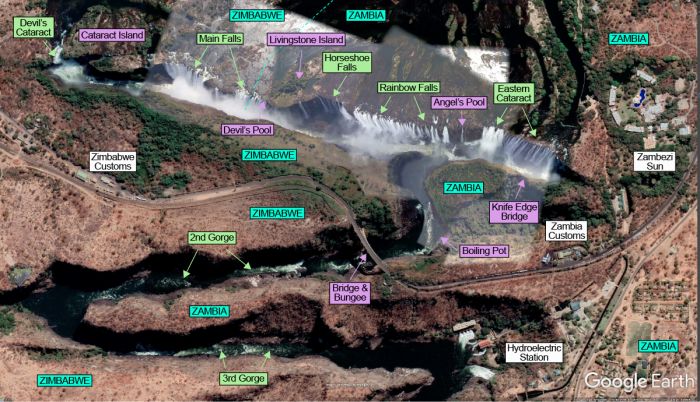
Overhead of The Falls (Copyright © James Weis).
The Gorges
The Falls are formed by a single vertical drop, spanning the entire width of the Zambezi River, into a transverse chasm called 1st Gorge. The depth of 1st Gorge varies from 260 feet (80 meters) on the western end to 354 feet (108 meters) in the center. The only outlet from the 1st Gorge into the series of gorges downstream is a 360-foot (110-meter) wide cleft about one-third of the way from the eastern side of First Gorge. Together, the gorges below The Falls are sometimes known as the Batoka Gorge.
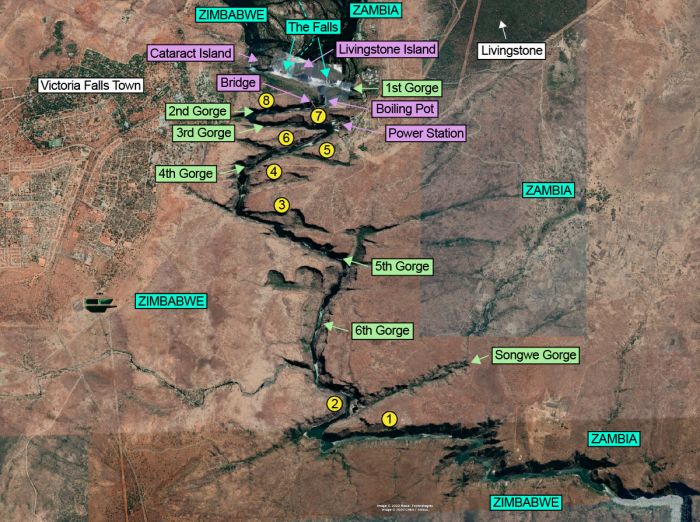
Aerial showing The Falls, Gorges, and past Falls positions (numbered 1-8) (Copyright © James Weis).
The water's exit passage from 1st Gorge extends for 490 feet (150 meters) before entering 2nd Gorge where it makes a sharp right turn. This huge rush of water, particularly in high flood, has over the years carved out a deep pool known as the "Boiling Pot". The Boiling Pot can be reached by descending a steep trail from the Zambian bank. The pool is calm at the surface during low water, but at high water there is considerable swirling turbulence and strong water currents.
The Victoria Falls Bridge spans 2nd Gorge just downstream from the Boiling Pot. From 2nd Gorge, the river flows through a progression of zig-zag gorges which are numbered in the order in which the river reaches them.
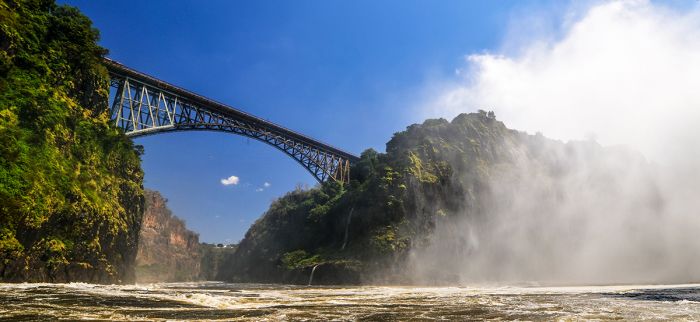
Looking up at The Falls Bridge from "Boiling Pot".
Water Flow Levels
The volume of water flowing over The Falls varies greatly during the year. The upper Zambezi River, which feeds into The Falls, experiences a rainy season from around late November until early April, with little to no rain for the remainder of the year.
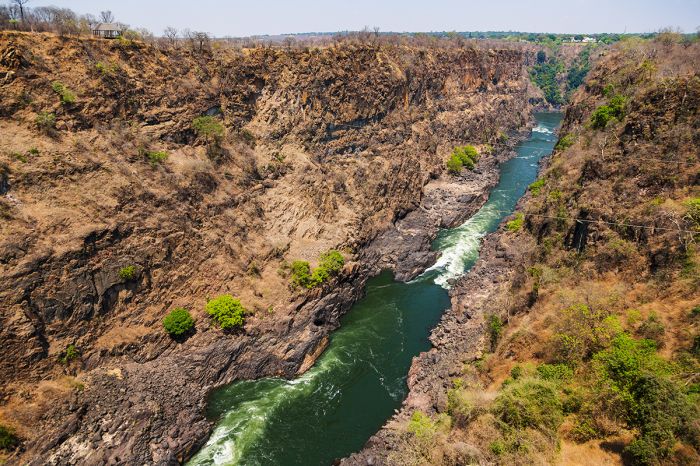
View from Falls Bridge down 2nd Gorge towards Zimbabwe.
High Water
High water levels reach The Falls from around February thru May, with the peak flows occurring in March or April (dependent upon rain timing and amount, this varies year to year). Water levels then decrease gradually until around December, when local rains begin to replenish the river.
During peak flow (March/April), roughly 200 million gallons (750 million liters) of water flow over the lip every minute. During the driest period (October/November), the flow can be as little as 2.6 million gallons (10 Million liters) per minute. Only the Iguazu Falls between Brazil and Argentina can rival this in terms of flow.
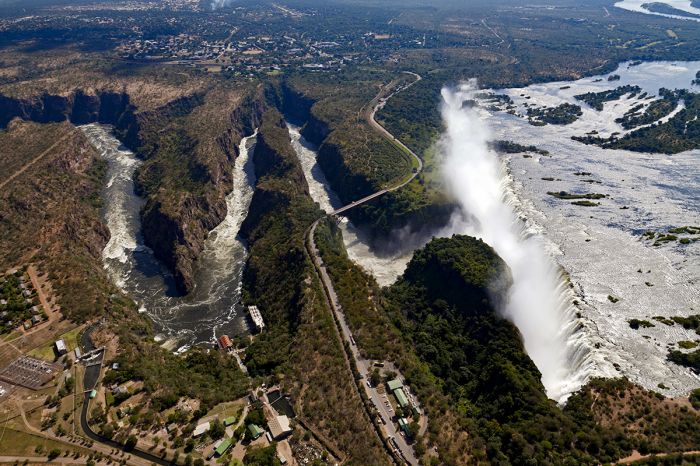
The Falls and 1st-4th Gorges at high water flow.
During high water months, the spray from The Victoria Falls, which is forced upward as the falling water hits the gorge below, rises to a height of 1 300-2 600 feet (400-800 meters) above the lip and can be seen from 30 miles (48 kms) away.
As the spray above The Falls condenses, it falls back as very localized rain, creating rainbows and giving life to the small rain forest sections on the rim of the banks opposite the falls. At full moon, visitors can explore the paths around The Falls to witness a lunar rainbow or "moonbow" in the spray.
The walking path on the Zambian side meanders along the cliff of 1st Gorge opposite the Eastern Cataract and through the small rainforest here. During high water, the spray falls back as a continuous gentle rain and getting wet is unavoidable. Furthermore, the massive cloud of spray rising from the gorge below, obscures good views of The Falls themselves. Rain gear is recommended as well as waterproof protection for electronics.
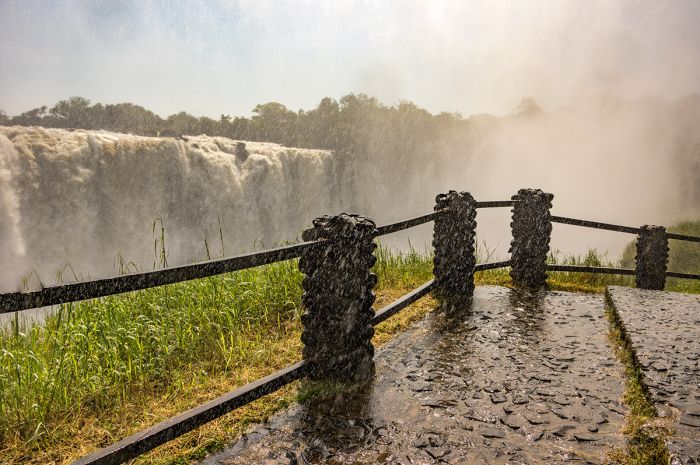
Viewpoint along the walking path at high water.
Low Water
When the water levels in the Zambezi River are lowest (typically October and November), most of the channels at the lip become mere trickles. The majority of the river flows over Devil's Cataract and Main Falls, while the flow on the eastern side of Livingstone Island all the way to the Zambian bank becomes just a small trickle. The portion of the waterfalls seen from the Zambian side may even dry up completely.
While the spectacular spray and rush of water are absent at this time of year, it is still quite interesting to be able to walk out a ways into the river above The Falls and see underlying rocks and geology. The gorges are also much more revealed at low water. The very popular "Devil's Pool" activity (read here) is also only available during low water.
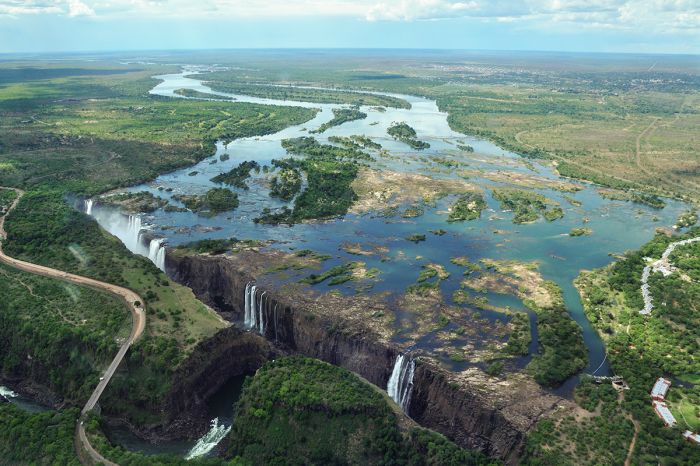
The Victoria Falls at low water (note the totally dry Zambian side).
Sights & Day Tours
Livingstone Island
Livingstone Island is located along the lip of The Falls, roughly in the middle and just inside the Zambian border, which runs through the center of the river and falls. The island is named for David Livingstone, who was the first European to see The Falls in 1885 and did so from this spot.
Guided tours to explore the island are run multiple times per day between July and March (and subject to water levels). The departure starts with a short motorized boat ride from the Zambian side, followed by a brief walk around the island and some refreshments and lunch or snacks. Tours also include a low water option of plunging into one of the world's most incredible natural infinity pools, Devil's Pool (see below).
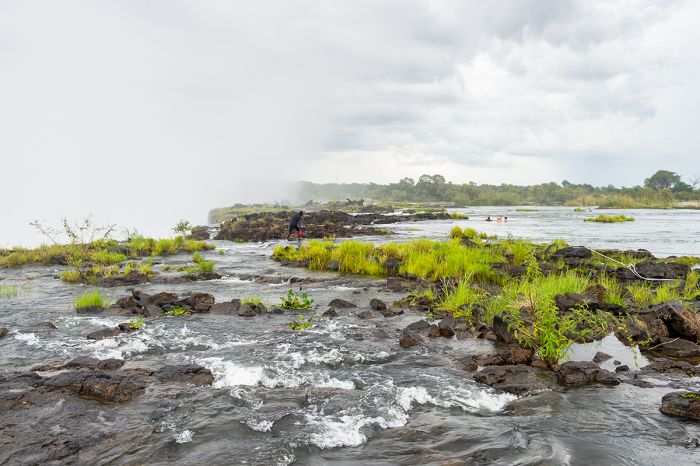
Tourists and guides walking/swimming from Livingstone Island to Devil's Pool.
Walking Tour of The Falls
The main foot path along the cliff opposite The Falls on the Zambian side is much shorter than the one on the Zimbabwean side, but still provides excellent views of the Eastern Cataract. The walking trail follows the edge of the gorge cliff, over the harrowing Knife Edge Bridge, through the small rainforest, and back in a loop.
There are superb vantage points along the way, including a great spot to watch bungee jumpers as they fly off the Falls Bridge. Walking can be done with a knowledgable guide (recommended) or on your own.
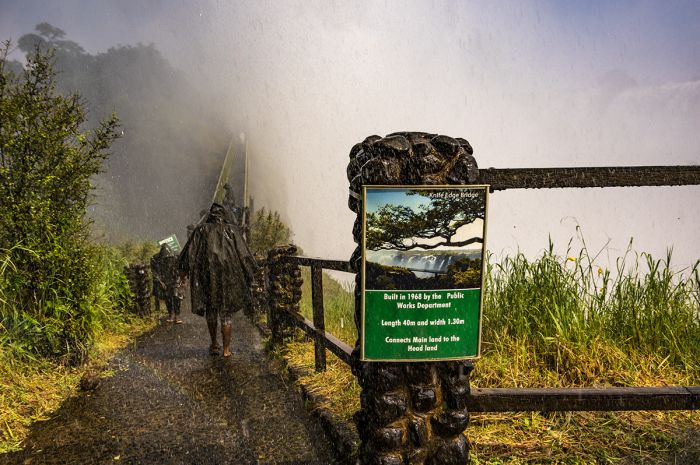
Visitors on Knife Edge Bridge at high water (note the raincoats)!
Boiling Pot
A foot path descends into the gorge and the edge of the water at Boiling Pot, a large swirling eddy of water just below the water's exit from 1st Gorge and just upstream of the Falls Bridge. The hike down is steep, including large cement steps and walking around large boulders, but worth the effort to see this beautiful spot at the bottom. Swimming is possible during low water. The spot is also the main launch point during the white-water rafting season.
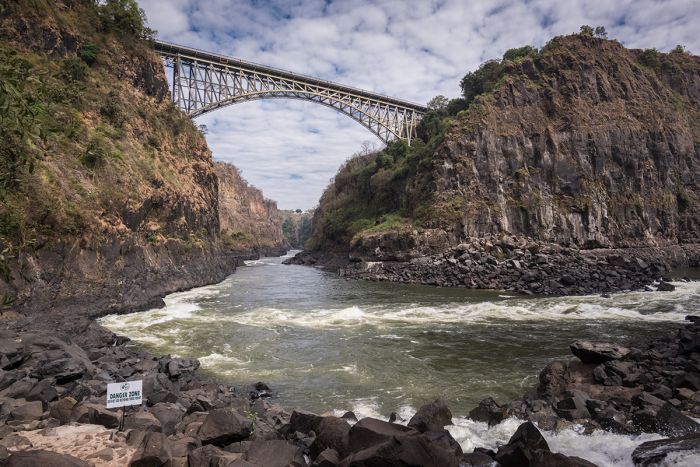
The Boiling Pot Trail ends at the bottom of the gorge.
River Cruises
Numerous operators offer leisurely boat excursions on the upper Zambezi River above The Falls. Sunset cruises are the most popular, but daytime outings are also available. Boat sizes and passenger loads vary from the double-decker African Queen riverboat, which offers live music, cocktails, and buffet snacks in an elegant setting, to small, private water craft, which may include breakfast or lunch on one of the Zambezi islands.
Wildlife commonly seen in the national parks on both sides of the river includes elephants, hippos, crocodiles, buffalo, antelopes, and plenty of birds, so be sure to bring your binoculars.
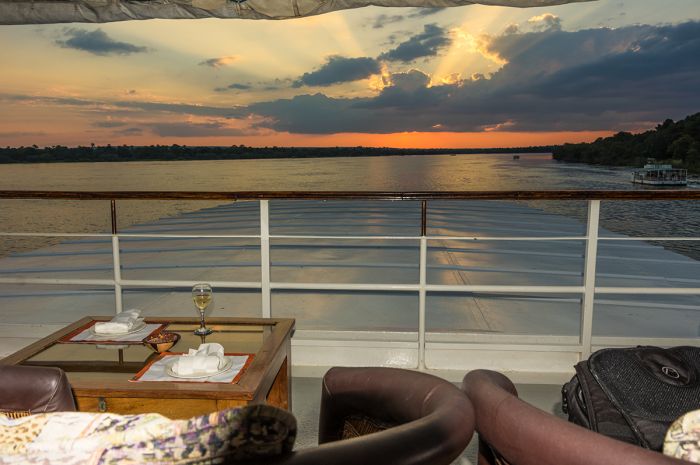
A sunset cruise on the Zambezi River near The Falls.
Fishing
The upper Zambezi waters are popular for sport fishing, particularly for the prized tiger fish, but also for bream and other species. Half- and full-day trips head upstream roughly 15-20 miles (25-30 kms) from Livingstone. Various outfitters offer everything needed, including fishing tackle, refreshments, and knowledgable guides.
Multi-day trips are also available, heading much further upriver for even better fishing. The best season for fishing the upper Zambezi is after the rains have abated, between May and September.
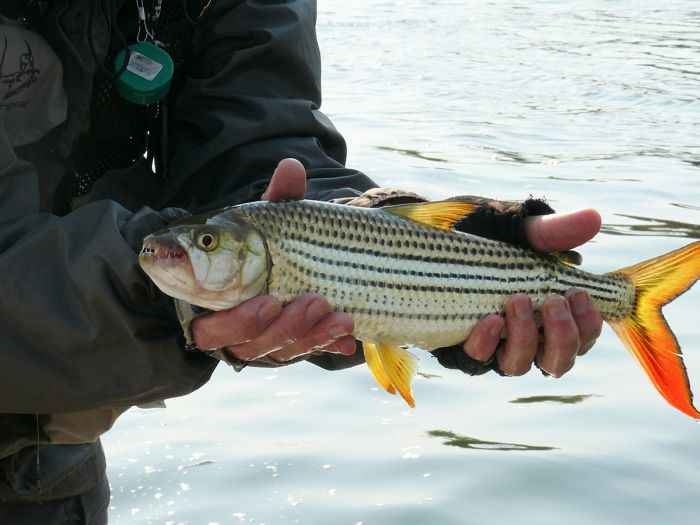
A tiger fish caught on the Upper Zambezi.
Markets
Livingstone has numerous lively markets which are fun to visit. The largest and most notable is the Maramba Market, which offers a wide assortment of items including fresh vegetables, spices, hand-crafted decor, clothing, African textiles, various curios, and more.
Many smaller craft markets, including one just across the bridge next to the Field Museum, are also worth a look. Mukuni Park in the town center offers another such market. These craft markets mainly offer hand-carved wood and stone decorations, African masks, drums, jewelry, and woven baskets. Bargaining is the name of the game here. Several local operators offered guided market tours.
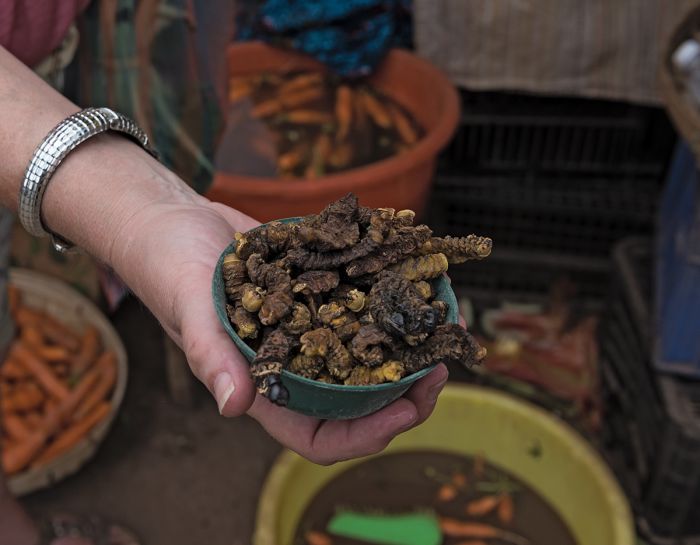
Mopane caterpillars (a local delicacy) in a Livingstone market.
Village Visits
For a cultural experience, a guided visit to one of the nearby villages will give insight into the life of local people living in a traditional setting.
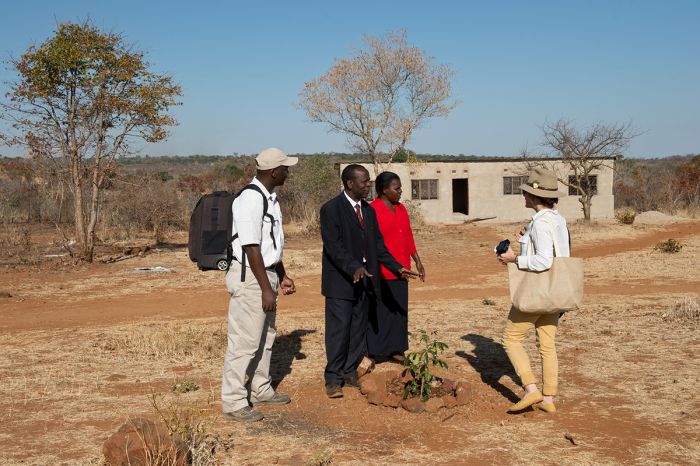
Village visits offer a glimpse of local culture (Copyright © Wilderness Safaris).
Mukuni Village, a settlement of over 8 000 Leya people, is located just 5 miles (8 kms) east of The Falls. Organized tours to Mukuni will give a glimpse of local life and offer opportunities to visit their basic huts, see locals at work, watch their curio-making, and sample local food and beer. Due to its close proximity to The Falls, Mukuni has become somewhat commercialized and dependent on tourism, making it less than 100% authentic.
Simonga Village, located 9 miles (15 kms) west of Livingstone, is another popular cultural destination that can be visited independently or as part of an organized tour. A guided tour will offer insights into daily village life, visits to the school and a traditional healer, cultural performances, and more. Basic overnight accommodation is also available for those who want to immerse themselves and sample the local cuisine.
Adventure Sports & Activities
The Victoria Falls area is the undisputed capital of adventure activities for Southern Africa. Popular adrenaline inducing adventures include white-water rafting, bungee jumping, abseiling, the gorge swing, kayaking, canoeing, microlight flights, helicopter rides, and more.
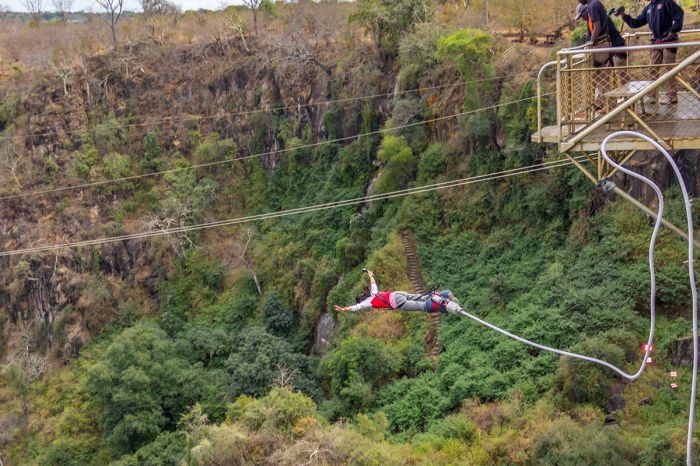
Bungee jumping off the Victoria Falls Bridge.
White-Water Rafting
The Zambezi River downstream from The Falls offers some of the most spectacular rapids and rafting scenery anywhere in the world and is renowned among enthusiasts. The rapids here are mostly Class IV and V, but no prior experience is required as the rafts are steered by experienced guides.
Rafting trips are offered by numerous operators on both the Zambia and Zimbabwe sides of the river. The rafting season can be generally divided into low-water and high-water seasons. The rafting seasons are totally dependent on rainfall and and water levels in the upper Zambezi River, so no two years are alike in terms of timing.
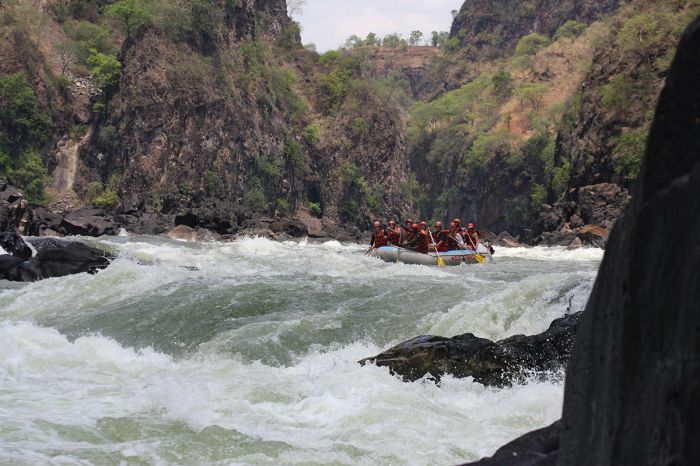
White-water rafting is an adrenaline-filled adventure at The Falls (Copyright © Wild Horizons).
Low-water Rafting
During low water (usually August thru late December), rafting trips cover a long stretch of the river. The rapids at this time of year are at their most spectacular, with lots of white water, exposed rocks, high waves and pronounced troughs. This is the most desirable time to experience rafting on the Zambezi.
Full- and half-day low-water trips depart from just below The Falls at Boiling Pot on the Zambian side (trips departing from the Zimbabwean side leave from above Rapid #4 at the turn into 3rd Gorge).
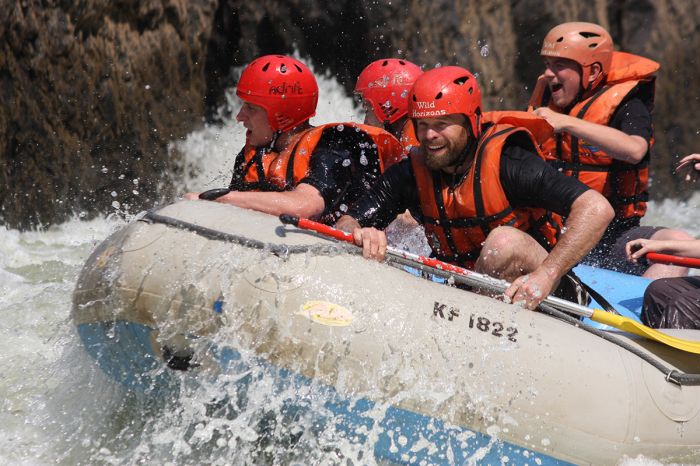
Riding the rapids in the gorge (Copyright © Wild Horizons).
Half-day low-water trips exit at Rapid #19, where rafters then climb to the top of the gorge for a picnic lunch. Arrival back in town is around 2-3pm. Full-day trips go all the way to Rapid #23, with a stop for lunch along the river. Multi-day trips covering up to 5-7 days are also possible, involving multiple portages and can continue all the way to the Matetsi River mouth.
High-water Rafting
Rafting is also offered during high water (generally February to July), but the trips are shorter, starting just below Rapid #9 on both sides of the river. Rapid #9 is always a walk-around/portage, as it is too dangerous even during low water. Although high water rafting may seem less dramatic, as there is much less white water, it is actually much more dangerous due to the vicious undercurrents and whirlpools. When the water becomes very high (usually March thru May), all rafting is postponed.
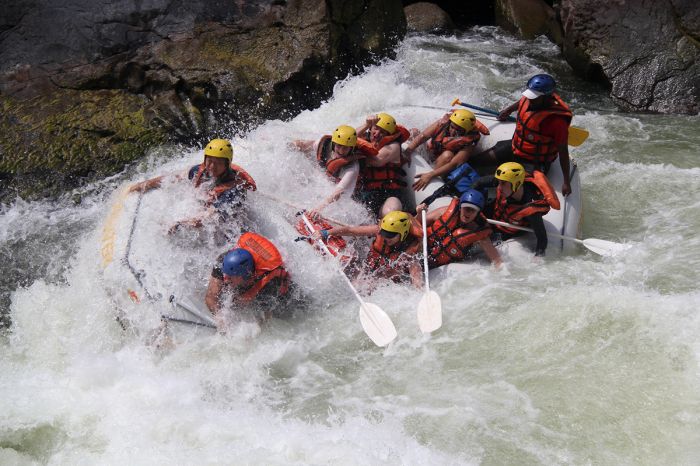
White-water rafting in the gorges below The Falls (Copyright © Wilderness Safaris).
Rafting Options
There are also two types of rafting trips offered: oar boat and paddle boat. All trips require passengers to wear floatation jackets and helmets, but there is always a risk of falling overboard or capsizes, which is of course the reason these trips are such a thrilling adventure.
The oar boat option involves essentially holding on and shifting your weight around the raft on demand of the guide, who essentially steers and navigates the raft through the rapids by himself. This is generally the easier way and also safer, as you can hang on at all times over the rapids and relax or take photos between rapids.
The paddle boat option is a more exciting experience and also riskier, as all passengers on the raft provide the power while the guide positions the boat and shouts out commands. Successful navigation is dependent on the group to paddle like crazy through the rapids and follow directions immediately when given. Every rafter is an active participant and just hanging on is not an option! Paddle boats are much more likely to have a capsize or swimmers, but this is a popular option, as it is much more active and thrilling.
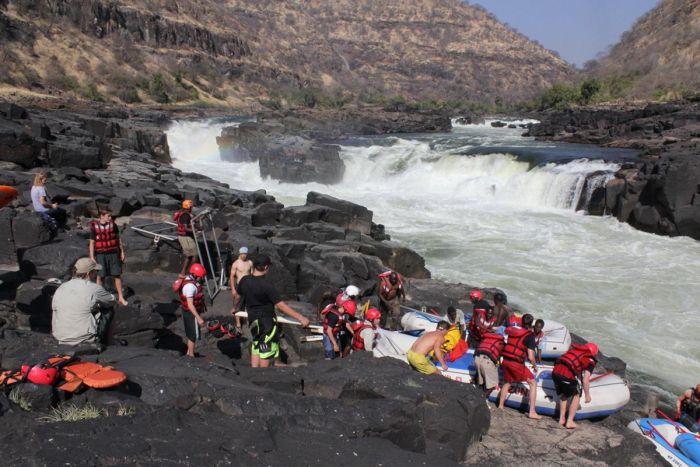
Portage on a rafting trip (Copyright © Wild Horizons).
Devil's Pool
From around mid-August to late December (October/November is best), the low water levels at The Falls allow daring visitors to take part in a guided adrenaline activity, by swimming a short distance from Livingstone Island to the "Devil's Pool".
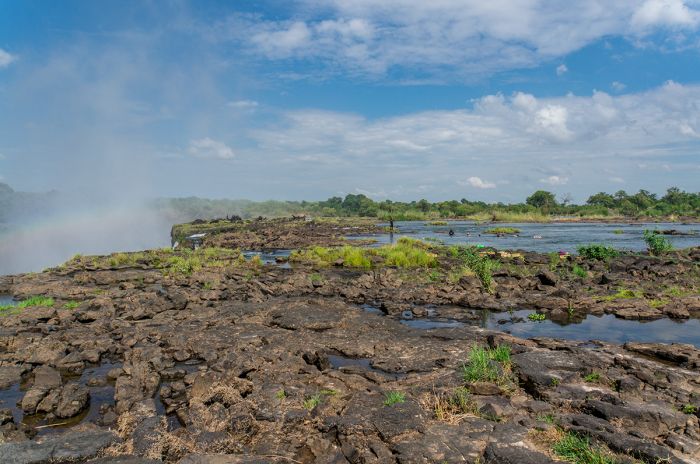
Swimmers heading out to Devil's Pool from Livingstone Island.
Devil's Pool is a natural pool of water created by a depression in a rock wall along the lip of The Falls that limits the water flow enough for people to sit safely within. This amazing infinity pool is located right at the precipice of The Falls and one can peer over the edge and down the long drop into the gorge below.
A second, but smaller pool called Angel's Pool, also situated at the edge of The Falls but on the other side of Livingstone Island is often available when Devil's Pool is closed. The Angel's Pool activity is generally open from April/May through September.
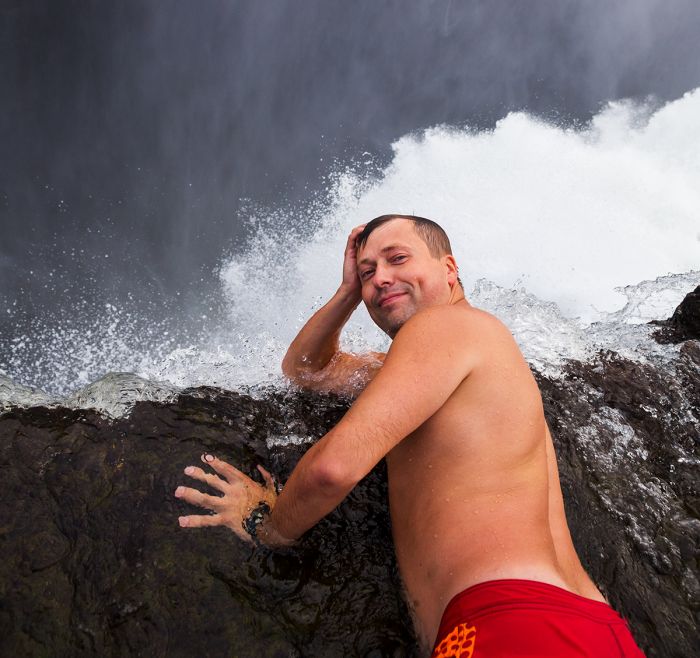
Lying at the lip of The Falls in Devil's Pool.
Bungee Jumping
Taking the leap off the Vic Falls Bridge and free falling 364 feet (111 meters) into the gorge with the Zambezi River water below is one of the most intense activities for adrenaline seekers. The jump is one of the world's highest. Tandem jumps are also offered. Jumpers are winched back up after the jump. During the rainy season (Nov-May), there are interruptions in this activity, as the cords have to be dry.
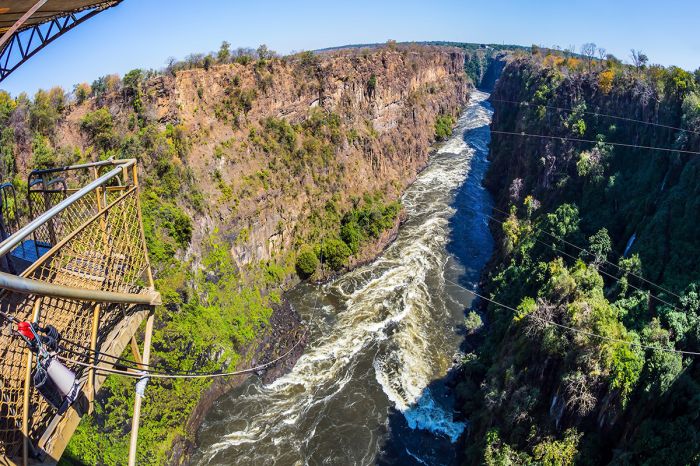
The view from the Bungee Jump platform on Victoria Falls Bridge.
Flight of the Angels
There are several ways to soar above The Falls for incredible bird's-eye views. These flights are commonly called the 'Flight of Angels', after the famous quote by the explorer David Livingstone. Options include helicopter, microlight, and light fixed-wing aircraft (also possible as part of a transfer flight to Kasane in Botswana en route to/from a safari).
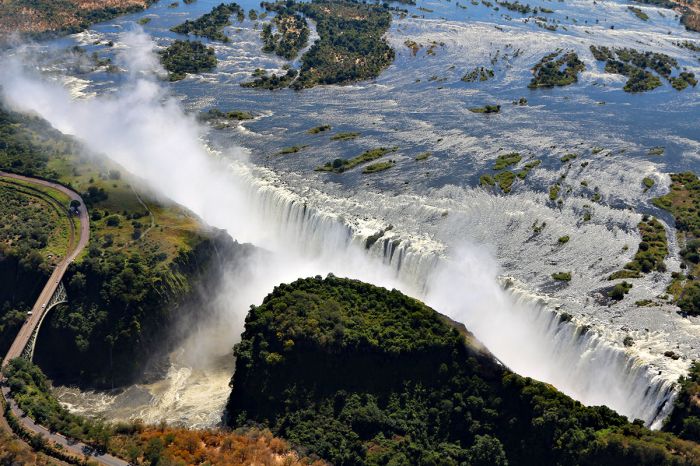
High water view from a helicopter .
Helicopter
Helicopter flights over The Falls are offered as 15- or 30-minute flips in choppers seating four, five, or six passengers. The shorter flights take in The Falls and a bit of the upper Zambezi and national parks, while the 30-minute flight includes the gorges below The Falls. Flights can also include landing downstream in one of the gorges for a picnic.
Flights are not cheap but offer a superb way to take in the full scale of the area. River rafters can also book a helicopter to take them out of the gorge at the end of their trip (instead of climbing out of the gorge).
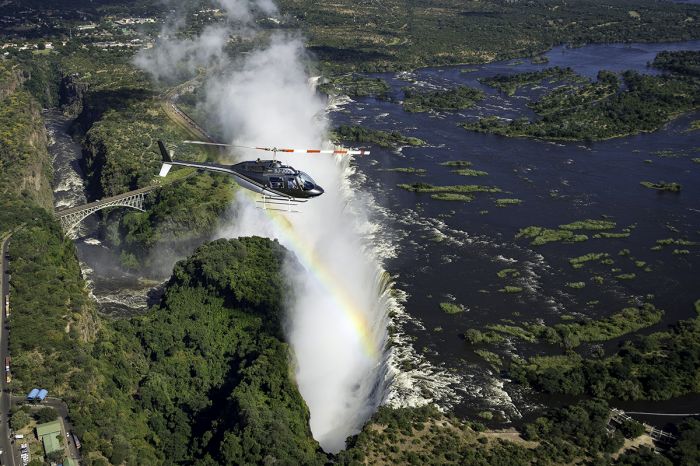
Helicopter flight over The Falls (Copyright © Batoka Sky).
Microlight
One of the greatest ways to take in The Falls is on an open-air, propeller-powered, two-seater microlight. These aircraft only have room for the pilot and one passenger (who sits behind the pilot) and are allowed to fly lower than helicopters over The Falls. The views are uninterrupted and breathtaking.
This activity is only offered on the Zambian side. To avoid midday turbulence, flights operate only in the morning and late afternoon. Options include a 15- or 30-minute flight. Cameras are forbidden for safety reasons, but videos and images are taken remotely and can be purchased.
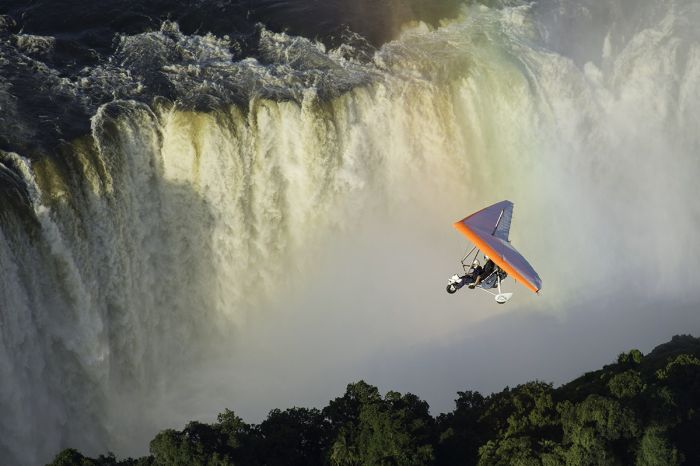
Microlight flight over The Falls (Copyright © Batoka Sky).
Other Adrenaline Adventures
There are seemingly endless adventures offered at The Falls and along the Zambezi River and its gorges. Some of the more popular activities not already described above include canoeing on the upper Zambezi River, abseiling, canopy tours, gorge swinging, river boarding, kayaking, zip lining, the flying fox, jet boating, the bridge slide, and the bridge walk. All of these will get your adrenaline flowing!
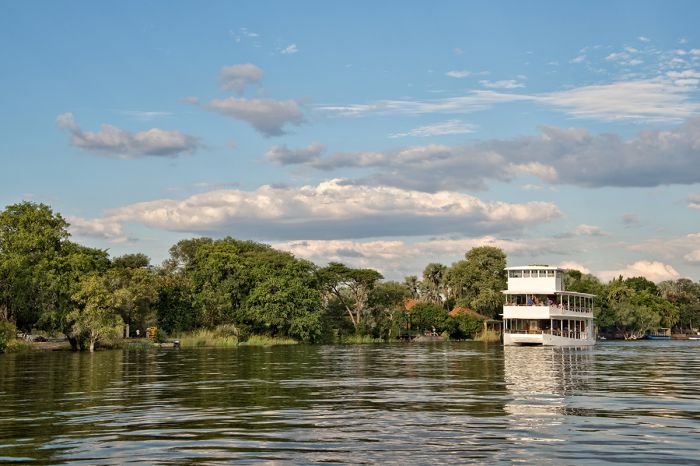
Cruise above The Falls on the Zambezi River.
Mosi-oa-Tunya National Park
There are three national parks protecting the land on both sides of the Zambezi River and around The Victoria Falls and its gorges. Two are on the Zimbabwe side, while Mosi-oa-Tunya (MOT) National Park protects the Zambian side.
MOT covers 27 square miles (70 sq kms) and is divided into two sections: the wildlife section in the northwest between Livingstone town and the river above The Falls; and the section beginning at The Falls and extending downstream to Songwe Gorge. There are separate gates for each section.
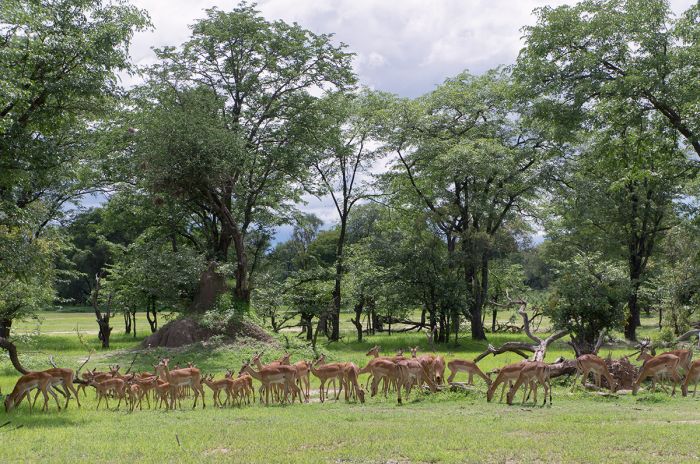
A herd of impala in Mosi-oa-Tunya National Park.
Visiting MOT's wildlife section will afford good chances at seeing elephant, white rhino, buffalo, bushbuck, blue wildebeest, giraffe, buffalo, zebra, and greater kudu. Crocodile and hippo are abundant along the river banks. Birding in the park is also very good, with over 250 species recorded.
Self-driving is permitted or you can join a guided game drive with one of numerous local operators. Walking safaris are also an option. Early mornings are the most productive time to visit.
Portions of Mosi-oa-Tunya National Park (Zambia) and Victoria Falls National Park (Zimbabwe), plus a riverine strip of Zambezi National Park (Zimbabwe) are protected as a UNESCO World Heritage Site covering a total area of 26 square miles (69 sq kms).
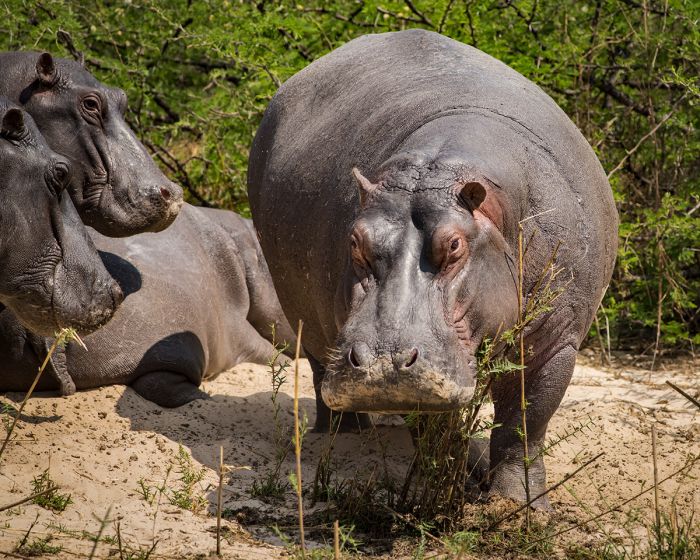
Hippos along the Zambezi River, Mosi-oa-Tunya National Park.
Livingstone Town
Once an overlooked town and playing second fiddle to the far more popular and developed Victoria Falls town on the Zimbabwe side of the river, Livingstone's tourism and development have surged in the last two decades. Capitalizing on the controversial political policies enacted by Zimbabwe's President Mugabe in 2000 and 2001, which resulted in negative press worldwide, Zambia saw its tourism grow at Zimbabwe's expense.
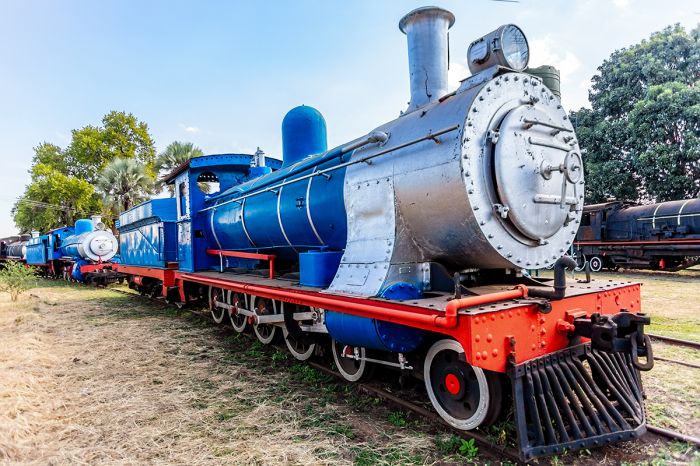
Vintage steel locomotive at Livingstone's Railway Museum.
Livingstone became a more attractive base for visitors to The Falls, mostly due to overreaction and fear over the negative news reports about Zimbabwe. New hotels and operators sprang up in Livingstone and tourism to Victoria Falls Town in Zimbabwe all but dried up for a few years. Today, Zimbabwe tourism is doing much better and safety is not a concern for visitors, but Livingstone certainly grew from Zimbabwe's losses.
Most of the better lodges and hotels are located along the Zambezi River or outside of the town of Livingstone, but the town itself has several markets and some accommodation. Harry Mwanga Nkumbula International Airport (LVI) is located on the north side of Livingstone. There are several good museums, including the Livingstone Museum, the Railway Museum, and the Field Museum.
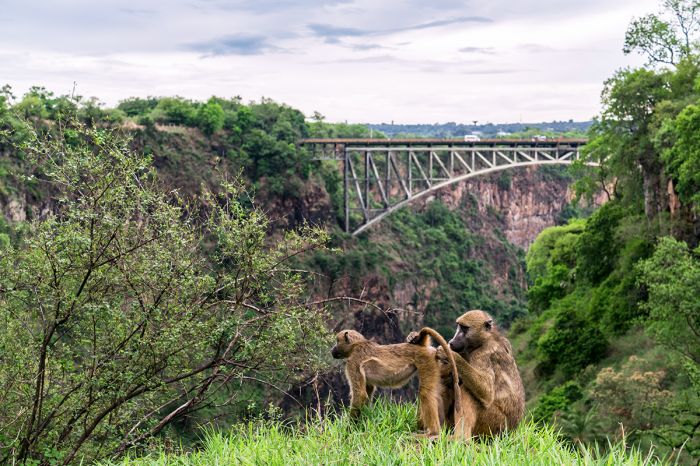
Baboons are common in the parks and along the gorges.
Read More...
Adrenaline Activities, Adventure Sports, Batoka Gorge, Boiling Pot, Bungee Jumping, Devil's Pool, Falls Tour, Fishing, Flight of the Angels, Geological History, High Water, Human History, Livingstone Island, Livingstone Town, Low Water, Markets, Mosi-oa-Tunya, Post-Independence History, River Cruises, Sights & Day Tours, The Victoria Falls, Village Visits, Water Flow Levels, White-Water Rafting
Great Good Fair Poor
- Jan
- Feb
- Mar
- Apr
- May
- Jun
- Jul
- Aug
- Sep
- Oct
- Nov
- Dec
Tourism to Livingstone is primarily based around seeing The Victoria Falls. There are distinct seasons based on how much water is flowing in the Zambezi River and over The Falls, and the experience is dramatically different depending on when you visit.
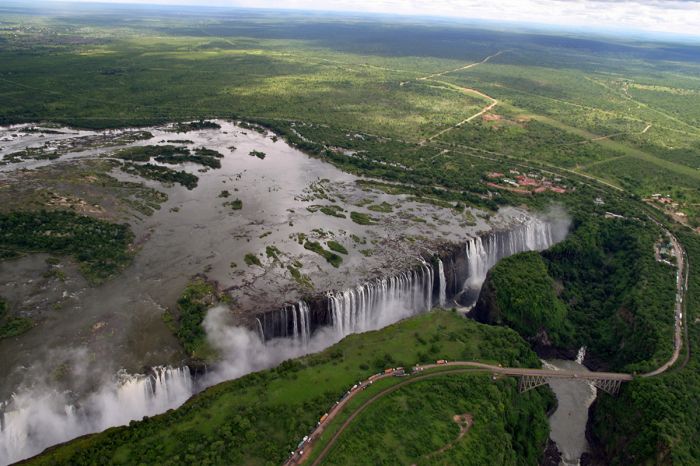
The Falls after the rains with high water flow.
The Falls / water levels
High Water
Rainfall in the catchment of the upper Zambezi River occurs between November and April. Much of this catchment is hundreds of miles north of Livingstone, so the high water levels at The Falls are typically between February and May, with the peak months being March and April. Note that the timing and amount of rainfall varies year to year and is never completely predictable. Beginning in May, the water flow over The Falls gradually decreases until December, when the local rainfall begins to raise the river again.
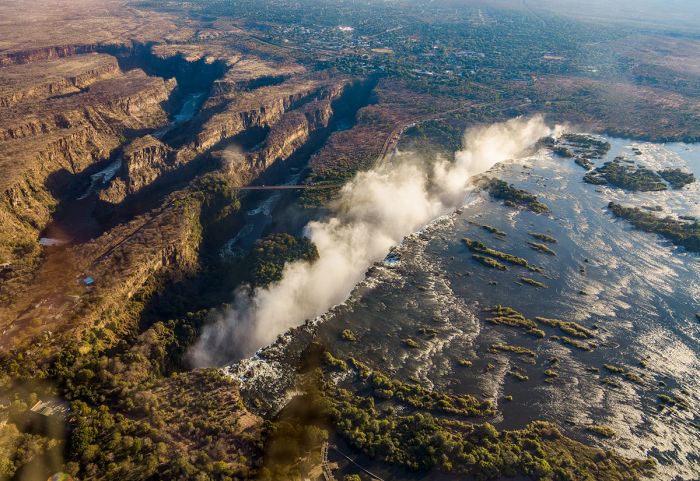
Spray rising from The Falls near the end of the high water period.
Viewing The Falls at high water means that actually seeing The Falls is almost impossible due to the tremendous amount of spray created when the torrential flow of water crashes into First Gorge below The Falls. The spray is forced upward and rises 1 300 to 2 600 feet (400-800 meters) above the lip and can be seen from 30 miles (48 kms) away. The incredible sound of the crashing water and the massive spray is what gave Victoria Falls its local name of 'Mosi-oa-Tunya', which means 'The Smoke that Thunders'.
The walking trail on the Zambian side brings you right along the cliff of the gorge opposite the Eastern Cataract falls and the spray means it will be very wet. The rising spray falls back as a steady but gentle rain and rain gear is suggested, along with waterproof coverings for your electronic gear, including cameras and phones.
A great way top see The Falls at high water is to take a helicopter or microlight flight above!
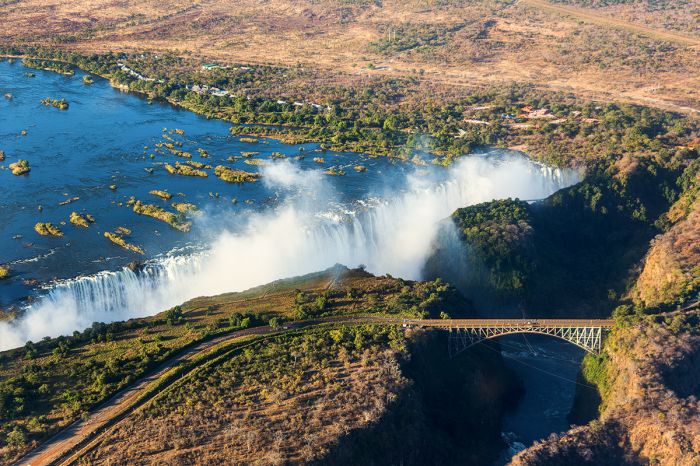
Landscape around The Falls drying up near the end of high water.
Low Water
The water levels begin to recede beginning in April and usually reach their lowest levels in October and November. At this time, most of the channels flowing over The Falls are just trickles of slow flowing water and the Eastern Cataract near the Zambian bank may even dry up completely.
While certainly less dramatic at low water, this is also a great time to visit The Falls, as you get a true appreciation of the geology of the gorges and can actually see clearly compared to a visit during high water, when the spray obscures much of The Falls. Walking out onto the rocks above The Falls (with a guide only) is possible and the popular "Devil's Pool" activity is only offered at low water (read more on the details tab).
White-water rafting is at its best during low water, with incredible rapids, large wave action and deep troughs.
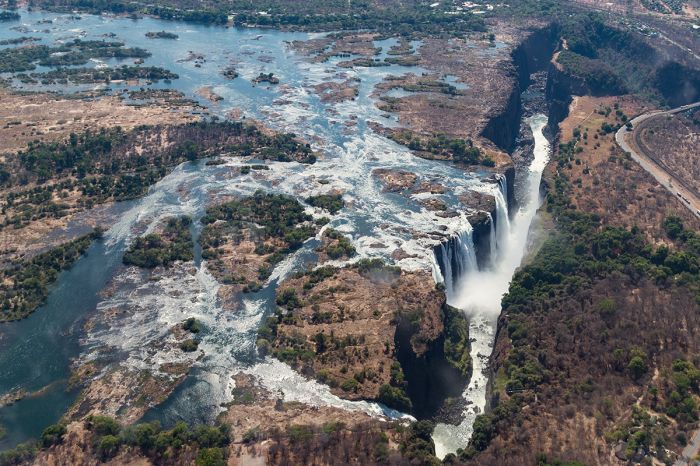
The Victoria Falls at low water showing the totally dry Zambian side.
Local weather
Dry Season / Winter
The dry winter season is from May through October and there is little to no rain at this time. Daytime temps are warm to hot, but the nights are cool and comfortable.
The local rains abate during April and May, but the landscape remains green and lush with rainwater still around in places. May temps average 80-84°F (27-29°C) with overnight temps falling to 50-54°F (10-11°C).
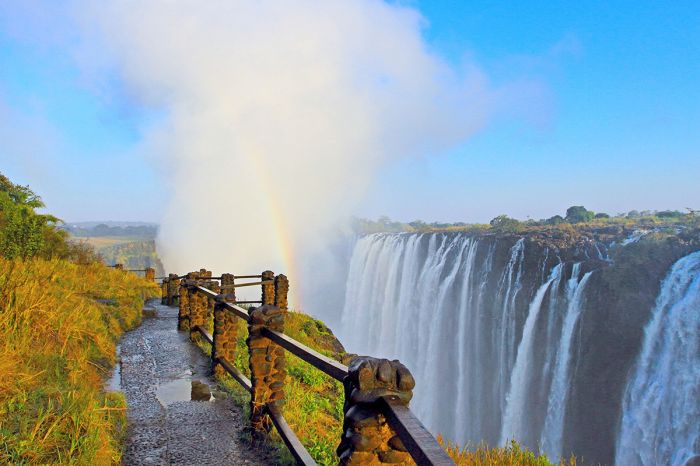
Viewpoint along the Zambian side walking trail opposite The Falls.
June and July bring dropping temps and these are the coolest months of the year, with no rainfall. Daytime temps average 77-81°F (25-27°C) and nights are chilly at 43-47°F (6-8°C). Morning activities can be chilly, so bring a fleece and a beanie.
August and September are dry and experience a warming trend. Daytime temps reach 88-93°F (31-34°C) and overnights are a comfortable 46-59°F (8-15°C).
October is very warm to hot and very dry. Daytime temps average 95-99°F (35-37°C) but can get even hotter on some days. Morning are the best time to be out, when temps are a more comfortable 62-66°F (17-19°C). Early rainfall often begins late in October, which brings a welcome relief.
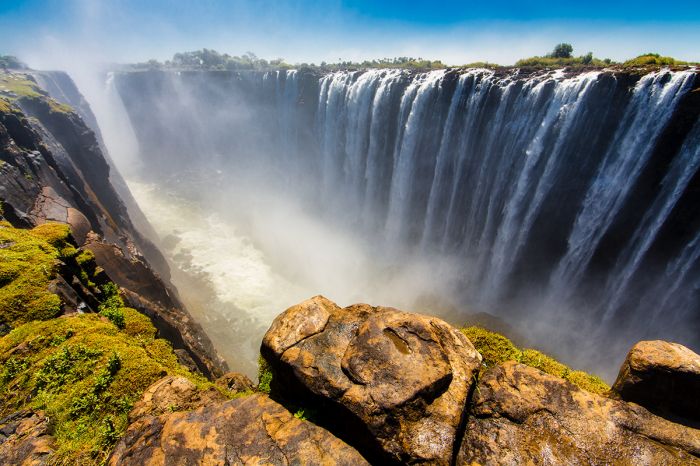
Spray rising from the gorge below The Victoria Falls.
Rainy Season / Summer
The rainy months are November through April. Rain often falls as afternoon thunderstorms and the days remain warm and humid. All-day rains are uncommon and most days experience some sunshine.
November brings the early rains (sometimes late October) and this is a welcome relief after the long dry winter. Daytime temps are very warm, averaging 86-90°F (30-32°C) with high humidity and the nights only drop to 66-70°F (19-21°C) . Afternoon rains are common.
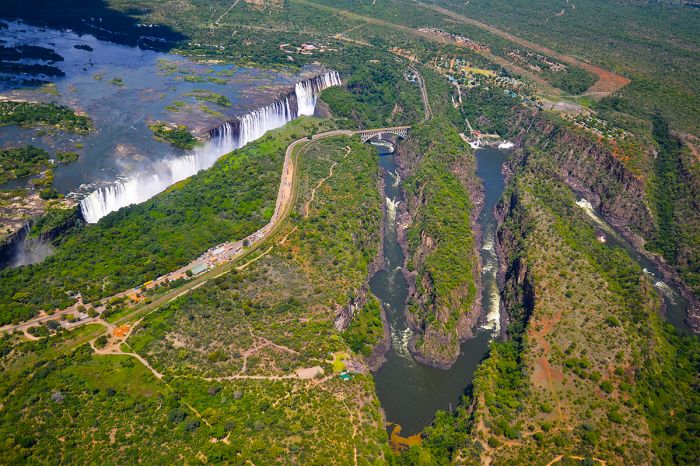
The Falls at high flow after good rains.
December through mid-March experience the highest rainfall, with rain occurring on most days, but almost never being an all-day affair. Daytime temps average 84-88°F (29-31°C) with overnights dropping to 65-68°F (18-20°C).
April is a very nice month in terms of weather, with rainfall uncommon and moderate temps. The landscape is verdant after the long rainy season. Daytime temps average 85-86°F (29-30°C).
Mosi-Oa-Tunya National Park
Game viewing in the wildlife section of Mosi-Oa-Tunya National Park (the northwest portion) is not heavily influenced by seasonality, other than the rains. Its small size and containment (fenced except along the river) mean that the antelopes and other general game are always there. Elephants move in and out, crossing the river between Zimbabwe and Zambia.
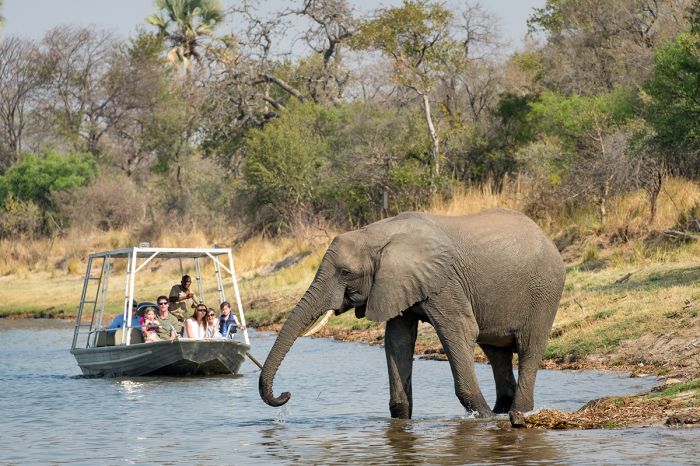
River safari along the Mosi-oa-Tunya National Park (Copyright © Wilderness Safaris).
Showing 1–2 of 2 results
Located away from the crowds around The Falls and within Mosi-oa-Tunya National Park on the bank of the Zambezi River. Easy access to The Falls by road or boat. Endless activities including boating, game drive safaris, fishing, culture, and adventures at The Falls.…




